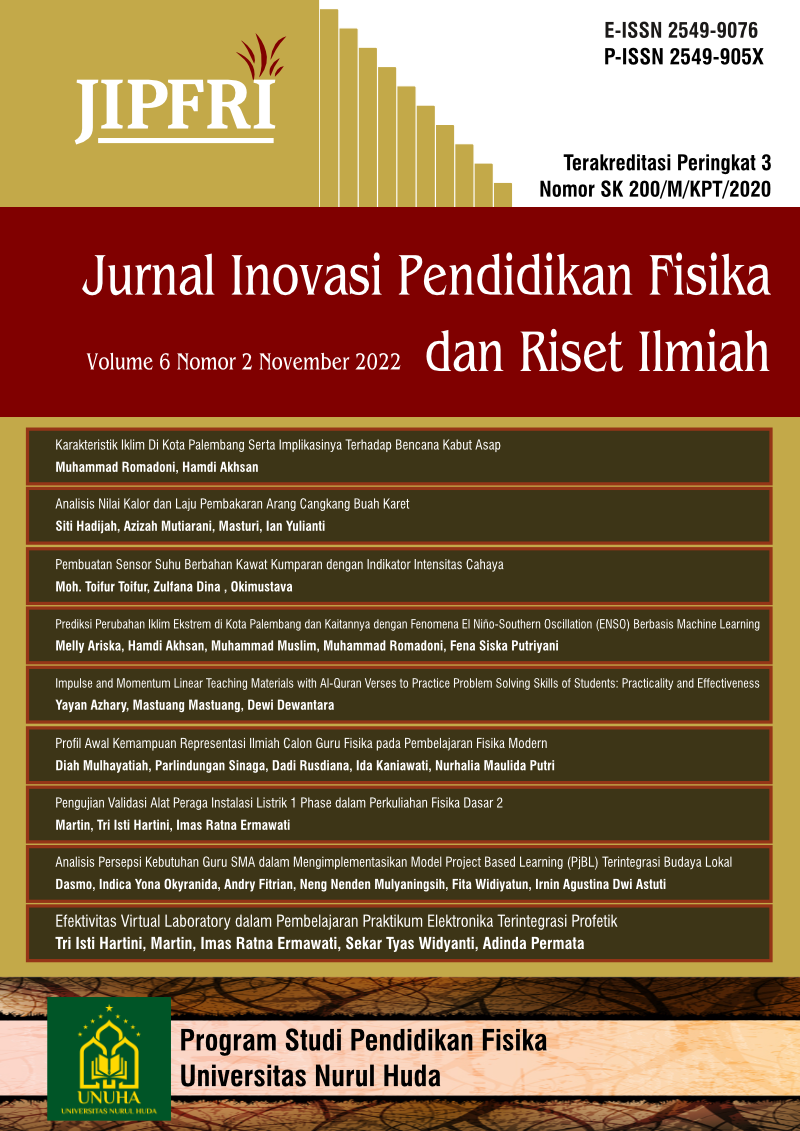Prediksi Perubahan Iklim Ekstrem di Kota Palembang dan Kaitannya dengan Fenomena El Niño-Southern Oscillation (ENSO) Berbasis Machine Learning
DOI:
https://doi.org/10.30599/jipfri.v6i2.1611Keywords:
Climate Change, ENSO, Rainfall, Niño 3.4, Machine Learning, Palembang CityAbstract
The purpose of this study is to provide predictions of climate conditions and trend of temperature rise in the city of Palembang in the 21st century. The BMKG station data used, namely SK Palembang and SM SMB II from the 2000-2020 period were analyzed based on the agreement of the Expert Team for Climate Change Detection and Indices (ETCCDI). ). Analysis using google colab shows that rainfall in the city of Palembang has a fairly high variability and a decrease in the number of rainy days that occur in the city of Palembang with the trend of air temperature, namely TMAXmean and TMINmean, has increased significantly by 2.40C for 50 years. Based on the correlation analysis between rainfall and El Niño-Southern Oscillation (ENSO) with Google Colab, a negative relationship was found. The El Niño-Southern Oscillation (ENSO) index used is the Niño 3.4 index. The study concluded that although the geographical location of Palembang city is located in the Asian Monsoon area, the ENSO phenomenon does not significantly affect rainfall variability in Palembang city.
Downloads
References
Ahmed, S. (2015). Modulation of East African Precipitation by the Indian Ocean Dipole ( IOD ) and ENSO By. ProQuest LLC.
Aldrian, E. (2007). Decreasing trends in annual rainfalls over Indonesia: A threat for the national water resource? J. Meteorologi Dan Geofi Sika, 7(April 2007), 40–49.
Aldrian, E., & Dwi Susanto, R. (2003). Identification of three dominant rainfall regions within Indonesia and their relationship to sea surface temperature. International Journal of Climatology, 23(12), 1435–1452. https://doi.org/10.1002/joc.950
Ariska, M., Akhsan, H., & Muslim, M. (2020a). DINAMIKA SISTEM MEKANIK NON-HOLONOMIK DENGAN METODE. 6(1), 20–23.
Ariska, M., Akhsan, H., & Muslim, M. (2020b). Potential energy of mechanical system dynamics with nonholonomic constraints on the cylinder configuration space. Journal of Physics: Conference Series, 1480(1). https://doi.org/10.1088/1742-6596/1480/1/012075
Bhatti, A. S., Wang, G., Ullah, W., Ullah, S., Hagan, D. F. T., Nooni, I. K., Lou, D., & Ullah, I. (2020). Trend in extreme precipitation indices based on long term in situ precipitation records over Pakistan. Water (Switzerland), 12(3), 1–19. https://doi.org/10.3390/w12030797
Cavazos, T. (2000). Using self-organizing maps to investigate extreme climate events: An application to wintertime precipitation in the Balkans. Journal of Climate, 13(10), 1718–1732. https://doi.org/10.1175/1520-0442(2000)013<1718:USOMTI>2.0.CO;2
Chang, C. P., Zhuo, W., John, M., & Ching-Hwang, L. (2005). Annual Cycle of Southeast Asia — Maritime Continent Rainfall and the Asymmetric. Journal of Climate, 18, 287–301.
Fitra S Pandia, Bandi Sasmito, A. S. (2019). Analisis Pengaruh Angin Monsun Terhadap Perubahan Curah Hujan Dengan Penginderaan Jauh (Studi Kasus: Provinsi Jawa Tengah). Jurnal Geodesi Undip, 8(1), 278–287.
Hendon, H. H. (2003). Indonesian rainfall variability: Impacts of ENSO and local air-sea interaction. Journal of Climate, 16(11), 1775–1790. https://doi.org/10.1175/1520-0442(2003)016<1775:IRVIOE>2.0.CO;2
Irfan, M., Virgo, F., Khakim, M. Y. N., Ariani, M., Sulaiman, A., & Iskandar, I. (2021). The dynamics of rainfall and temperature on peatland in South Sumatra during the 2019 extreme dry season. Journal of Physics: Conference Series, 1940(1), 012030. https://doi.org/10.1088/1742-6596/1940/1/012030
Lestari, D. O., Studi, P., Lingkungan, I., Pascasarjana, P., & Sriwijaya, U. (2019). KAJIAN ANOMALI IKLIM DI KAWASAN INDO- PASIFIK DAN PENGARUHNYA TERHADAP IKLIM.
Mulyana, E. (2002). Hubungan Antara ENSO dengan Variasi Curah Hujan di Indonesia. Jurnal Sains & Teknologi Modifikasi Cuaca, 3(1), 1–4.
Nur’utami, M. N., & Hidayat, R. (2016). Influences of IOD and ENSO to Indonesian Rainfall Variability: Role of Atmosphere-ocean Interaction in the Indo-pacific Sector. Procedia Environmental Sciences, 33, 196–203. https://doi.org/10.1016/j.proenv.2016.03.070
Rajendra K. Pachauri, Leo Meyer, T. C. W. T. (2014). Contribution of Working Groups I, II and III to the Fifth Assessment Report of the Intergovernmental Panel on Climate Change [Core Writing Team, R.K. Pachauri and L.A. Meyer (eds.)]. IPCC, Geneva, Switzerland, 155.
Rouw, A., Hadi, T. W., K, B. T. H., & Hadi, S. (2014). Analisis Variasi Geografis Pola Hujan di Wilayah Papua Geographic Variation Analysis of Rainfall Pattern in Papua Region. Jurnal Tanah Dan Iklim, 38(1), 25–34. http://ejurnal.litbang.pertanian.go.id/index.php/jti/article/view/6245
Sari, F. M. (2016). Peramalan Curah Hujan Ekstrim Secara Spasial (Studi Kasus: Curah Hujan Bulanan Di Kabupaten Indramayu). Sambutan Ketua Panitia. https://www.researchgate.net/profile/Risni_Yuhan/publication/328449445_Prosiding_SEMASTAT_2016/links/5bced5f9a6fdcc204a0138d2/Prosiding-SEMASTAT-2016.pdf#page=105
Sipayung, S. B., Avia, L. Q., Dasanto, B. D., & Sutikno. (2007). Analisis Pola Curah Hu]an Indonesia Berbasis Luaran Model Sirkulasi Global (Gcm). Jurnal Sains Dirgantara, 4(2), 145–154. http://jurnal.lapan.go.id/index.php/jurnal_sains/article/viewFile/669/587
Tanaka, H., & Yamanaka, M. D. (1985). Atmospheric by the Circulation Mesoscale in the Lower Stratosphere Breakdown Induced Mountain Wave By Hiroshi Tanaka and Manabu D . Yamanaka1 ( Manuscript received 19 September 1983 , in revised form 11 October 1985 ) Abstract. Journal of the Meteorological Society of Japan, December.
Tangang, F. T., & Juneng, L. (2004). Mechanisms of Malaysian rainfall anomalies. Journal of Climate, 17(18), 3616–3622. https://doi.org/10.1175/1520-0442(2004)017<3616:MOMRA>2.0.CO;2
Torrence, C., & P. Compo, G. (1998). Practical Guide Wavelet Analysis. Bulletin of the American Meteorological Society, 79(1), 61–78.
William J. Emery and Richard E. Thomson. (2016). Data Analysis Methods in Physical Oceanogrraphy.
Yamanaka, M. D. (2016). Physical climatology of Indonesian maritime continent: An outline to comprehend observational studies. Atmospheric Research, 178–179, 231–259. https://doi.org/10.1016/j.atmosres.2016.03.017
Yulihastin, E. (2010). Mekanisme Interaksi Monsun Asia dan Enso. Berita Dirgantara, 11(3), 99–105.
Downloads
Published
How to Cite
Issue
Section
License
Copyright (c) 2022 Melly Ariska, Hamdi Akhsan, Muhammad Muslim, Muhammad Romadoni, Fena Siska Putriyani

This work is licensed under a Creative Commons Attribution-ShareAlike 4.0 International License.










